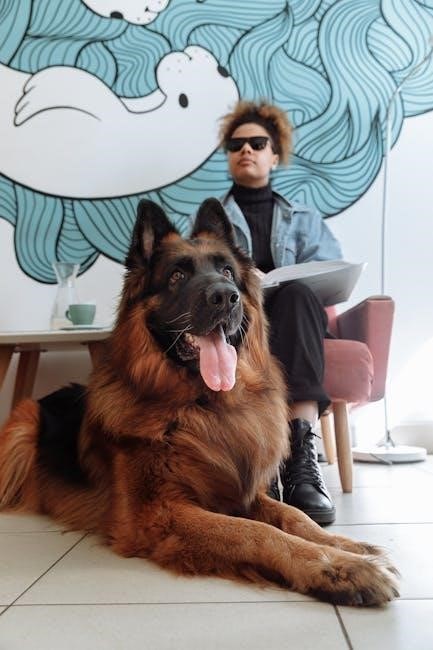Guide Dogs for the Blind primarily uses Labrador Retrievers, Golden Retrievers, and their crossbreeds. These dogs are trained to assist individuals with visual impairments, providing independence and mobility.
Guide Dogs for the Blind (GDB) is a renowned organization dedicated to empowering individuals with visual impairments by providing them with highly trained canine companions. Since its inception, GDB has been a leader in breeding, raising, and training Labrador Retrievers, Golden Retrievers, and their crossbreeds to serve as guide dogs. These dogs undergo rigorous training to assist their owners in navigating daily life, ensuring safety, and fostering independence. The organization emphasizes the unique bond between a guide dog and its handler, tailored to meet specific needs. GDB also offers extensive support services, including post-adoption training and ongoing assistance, to ensure a seamless transition for both the dog and the individual. Their mission is to enhance the quality of life for those with visual impairments through the unwavering support of their loyal guide dogs.
The Importance of Guide Dogs for the Blind
Guide dogs play a transformative role in the lives of individuals with visual impairments, offering unparalleled independence and mobility. Trained to navigate obstacles and guide their handlers safely, these dogs enable users to engage fully in daily activities, fostering confidence and self-reliance. Beyond physical assistance, guide dogs provide emotional support and companionship, reducing feelings of isolation. Their presence empowers individuals to participate actively in their communities, pursue careers, and maintain an independent lifestyle. The bond between a guide dog and its handler is deeply personal, creating a partnership that enhances overall well-being and quality of life. This unique relationship underscores the profound impact of guide dogs on both practical and emotional levels.

The Adoption Process
The adoption process for guide dogs involves a detailed application, vision assessment, and home evaluation to ensure a suitable match. Training and post-adoption support are provided.
Eligibility Criteria for Adopting a Guide Dog
To qualify for a guide dog, applicants must undergo a vision assessment to determine suitability. They don’t need to be totally blind but must demonstrate a need for assistance. A safe, hazard-free living environment and a secure yard are required. Applicants must also show the ability to care for a dog and commit to ongoing training. The dog must be the primary mobility aid, and breed preferences, such as Labradors or Golden Retrievers, may apply. The adoption process includes a detailed application, home evaluation, and medical clearance. References and lifestyle assessments ensure a compatible match between the individual and the guide dog.
How to Apply for a Guide Dog
To apply for a guide dog, individuals must contact a certified organization, such as Guide Dogs for the Blind, and submit a detailed application. The process begins with an initial inquiry and consultation to discuss needs and suitability. A formal application follows, requiring medical clearance and lifestyle information. Applicants may undergo an interview to assess their mobility and independence goals. A home visit is conducted to evaluate the living environment for safety and accessibility; Once approved, applicants are matched with a dog based on their specific needs and the dog’s temperament. Training is then scheduled, either on-site or at home, to ensure a smooth transition. Follow-up support is provided to ensure the partnership thrives.
Costs Associated with Adopting a Guide Dog
The costs of adopting a guide dog can vary, but many organizations, like Guide Dogs for the Blind, cover initial training and placement fees. Applicants may not incur direct costs for the dog itself, as these expenses are often funded through donations. However, adopters are typically responsible for ongoing expenses, such as food, veterinary care, and equipment like harnesses or leashes. Annual costs can range from $500 to $1,000, depending on the dog’s needs and local prices. Some organizations may also require a small application fee. Despite these costs, the benefits of independence and companionship far outweigh the financial investment for many individuals.
Post-Adoption Support and Training
After adopting a guide dog, organizations like Guide Dogs for the Blind provide comprehensive post-adoption support and training to ensure a smooth transition. Trained instructors conduct home visits to assist with integration, addressing specific needs and environments. Follow-up sessions are scheduled to monitor progress and provide additional guidance. Ongoing support is available to address any challenges or questions that arise. The organization often offers resources for public access training adjustments and behavioral tips. This commitment ensures both the dog and owner thrive together. The focus is on fostering independence and confidence, with support continuing beyond the initial adoption phase. Regular check-ins and access to trainers are standard practices to guarantee long-term success and satisfaction for both the individual and their guide dog.


Training Process
The training process for guide dogs involves puppy raising, advanced instruction, and public access preparation. Trained instructors ensure dogs master specific skills tailored to assist individuals with visual impairments, fostering independence and confidence. The dogs learn to navigate obstacles, respond to commands, and function calmly in public settings. This comprehensive approach equips guide dogs with the ability to serve as reliable companions and navigational aids, enhancing the quality of life for their owners;
Puppy Raising and Early Training
Puppy raising is the foundation of guide dog training, typically beginning when dogs are 8-10 weeks old. Volunteer raisers care for the puppies, teaching basic obedience and socialization skills. Puppies learn to interact with people, other animals, and various environments, ensuring they adapt to diverse situations. During this phase, puppies are introduced to essential commands like “sit,” “stay,” and leash walking. Socialization is critical to prepare them for future roles as guide dogs. At around 12-14 months, puppies transition to advanced training, building on the skills developed during their early years. This phase sets the stage for their eventual role as reliable, skilled companions for individuals with visual impairments.
Advanced Training for Guide Dogs
Advanced training for guide dogs builds on the foundation established during puppy raising. Dogs are paired with professional trainers who teach specific guiding skills, such as navigating obstacles, stopping at curbs, and avoiding hazards. Training includes complex commands like “forward,” “halt,” and “clearing,” ensuring the dog can safely guide its future handler. This phase also focuses on traffic awareness and responding to environmental cues. Dogs learn to prioritize their handler’s safety, even ignoring distractions. The training emphasizes obedience and focus, preparing the dog to work in busy public spaces. This critical phase typically lasts several months, equipping the dog with the skills needed to become a reliable, skilled companion for individuals with visual impairments.
Public Access Training for Guide Dogs
Public access training is a critical phase where guide dogs learn to navigate public environments confidently. Dogs are trained to maneuver through crowded spaces, climb stairs, and operate elevators. They also learn to avoid distractions, such as other animals or food, while remaining focused on their handler. Trainers simulate real-life scenarios to prepare the dogs for various public settings, ensuring they can guide their handlers safely. This training emphasizes obedience and composure in busy areas, such as restaurants, stores, and public transportation. By the end of this phase, guide dogs are equipped to handle the challenges of public outings, providing their handlers with greater independence and confidence in everyday life.

Breed Selection
Labrador Retrievers, Golden Retrievers, and their crossbreeds are commonly chosen for guide dog roles due to their intelligent, loyal, and calm temperament, making them ideal for guiding tasks.

Labrador Retrievers as Guide Dogs
Labrador Retrievers are one of the most popular breeds used as guide dogs due to their intelligence, loyalty, and calm temperament. Their gentle nature makes them highly suitable for assisting individuals with visual impairments. Labs are easy to train and excel in understanding commands, which is crucial for guiding tasks. They are also known for their strong work ethic and ability to remain focused in diverse environments. Their friendly and approachable demeanor helps users navigate social situations with confidence. Labs are often chosen for their versatility and ability to adapt to various lifestyles, making them an ideal choice for guide dog programs worldwide.
Golden Retrievers as Guide Dogs
Golden Retrievers are highly favored as guide dogs due to their friendly, intelligent, and loyal nature. Their strong work ethic and ability to remain calm in stressful situations make them ideal for assisting individuals with visual impairments. Golden Retrievers are highly trainable and excel in understanding complex commands, which is essential for navigating various environments. Their natural instinct to please and their strong bond with owners enhance their effectiveness as guide dogs. Additionally, their adaptability to different living situations—from bustling cities to quiet homes—makes them a versatile choice. Their quick learning ability and focus on tasks ensure they provide reliable assistance, making them a top choice for guide dog programs.
Labrador-Golden Retriever Crossbreeds
Labrador-Golden Retriever crossbreeds, often referred to as Goldadors, are increasingly popular as guide dogs due to their unique combination of traits. These dogs inherit the intelligence and loyalty of Golden Retrievers and the energetic yet calm temperament of Labradors, making them highly suitable for assisting individuals with visual impairments. Their balanced nature allows them to adapt to various environments, from busy urban settings to quieter home environments. Crossbreeds are also known for their strong work ethic and ability to focus, which are essential for guide dog responsibilities. Additionally, their versatility in size and coat type makes them a practical choice for a wide range of users. This hybrid breed is widely used by guide dog organizations due to their reliable performance and affectionate demeanor.

Benefits and Challenges
Guide dogs provide emotional support and independence, enabling users to navigate confidently. However, they require consistent care, training, and attention, presenting unique challenges for owners.
Emotional Support and Companionship
Guide dogs offer more than physical assistance; they provide profound emotional support and companionship. Their presence reduces feelings of isolation, fostering confidence and independence. The bond between a handler and their guide dog is deeply personal, creating a sense of trust and security. These dogs often act as social bridges, helping their owners connect with others in public spaces. Their calm and well-behaved nature makes them approachable, breaking down social barriers. Beyond their practical roles, guide dogs bring joy and comfort, enriching their owners’ lives in countless ways. This emotional connection is a vital aspect of their role, making them invaluable companions.
Independence and Mobility
Guide dogs play a crucial role in enhancing the independence and mobility of individuals with visual impairments. These specially trained dogs navigate obstacles, stop at curbs, and avoid hazards, enabling their owners to move confidently through various environments. By providing physical guidance, guide dogs empower individuals to perform daily tasks and travel independently, reducing reliance on others. This newfound freedom fosters self-reliance and confidence, allowing people to fully engage in their communities and live fulfilling lives. The ability to navigate safely and efficiently is a cornerstone of what guide dogs offer, making them indispensable companions for independence and mobility.
Challenges of Raising a Guide Dog
Raising a guide dog comes with unique challenges that require dedication and patience. The initial phase of puppy raising is a time-consuming process that demands consistent training and socialization. Ensuring the puppy adapts to various environments and situations is crucial but can be stressful. As the dog matures, the training intensity increases, requiring handlers to possess strong communication and leadership skills. Additionally, the emotional bond formed during raising can make it difficult when the dog transitions to formal guide training. Balancing the dog’s working role with its companion nature is another challenge. Public access training also tests the dog’s behavior in distracting settings, adding to the responsibilities of the handler. Despite these challenges, the rewards of contributing to a guide dog’s journey are immense.

Legal Aspects
Federal laws protect guide dogs’ access to public spaces, ensuring equal rights for their owners. These protections are crucial for independence and mobility in society.
Laws Regarding Guide Dogs in Public Spaces
Federal and state laws protect the rights of guide dog owners, ensuring access to public spaces like restaurants, transportation, and retail stores. The Americans with Disabilities Act (ADA) prohibits discrimination against individuals with disabilities, requiring businesses to accommodate guide dogs. Similar laws exist internationally, such as the UK’s Equality Act, granting guide dogs equal access. These laws aim to promote independence and dignity for visually impaired individuals. Violations can result in penalties, reinforcing the importance of compliance. By safeguarding these rights, societies enable guide dog owners to navigate public environments seamlessly, fostering inclusivity and equality.
Rights of Guide Dog Owners
Guide dog owners have legal rights ensuring their independence and dignity. Under the Americans with Disabilities Act (ADA) and similar international laws, guide dogs are recognized as working animals, not pets. Owners cannot be denied access to public spaces, transportation, or employment. These rights extend to housing, healthcare, and educational institutions. Guide dogs are protected from discrimination, and their owners are entitled to equal opportunities in all aspects of life. These rights promote independence and dignity, allowing individuals with visual impairments to fully participate in society. Similar protections exist in countries like the UK under the Equality Act, ensuring global recognition of guide dog owners’ rights.

Living with a Guide Dog
Living with a guide dog creates a unique partnership, blending daily responsibilities like grooming and exercise with the joy of companionship and mutual reliance.

Daily Life with a Guide Dog
Daily life with a guide dog involves a harmonious blend of routine and adaptability. These dogs are trained to navigate obstacles, stop at curbs, and avoid hazards, ensuring safe mobility. Owners must establish a consistent routine, including regular feeding times, exercise, and grooming. Guide dogs are highly focused during work but become affectionate companions in downtime. Their presence fosters independence, allowing individuals to engage fully in daily activities. The bond between owner and dog is rooted in trust and mutual reliance, creating a profound emotional connection. Proper care and maintenance are essential to sustain their health and working ability, ensuring a fulfilling partnership.
Care and Maintenance Tips
Proper care and maintenance are crucial for the well-being of guide dogs. Regular grooming, including nail trimming and coat brushing, helps prevent health issues. A balanced diet tailored to their age and activity level is essential, along with fresh water at all times. Daily exercise, such as walks and playtime, keeps them physically and mentally healthy. Regular veterinary check-ups ensure early detection of potential health problems. Cleaning their harness and equipment regularly maintains hygiene. Training reinforcement and mental stimulation are also vital to sustain their working abilities. A safe, comfortable living environment and consistent routines further support their overall health and performance as guide dogs.
Guide dogs for the blind adoption is a life-changing opportunity that offers independence, companionship, and mobility to individuals with visual impairments. These specially trained dogs are more than just pets; they are trusted companions and navigational aids. The adoption process, while thorough, ensures a perfect match between the dog and handler. With proper care, training, and support, guide dogs thrive in their roles. Their ability to empower individuals to live fulfilling lives highlights the profound impact of these incredible animals. If you’re considering adoption, remember the rewards of providing a loving home to a dog that will transform someone’s life. Your support can make a lasting difference.


